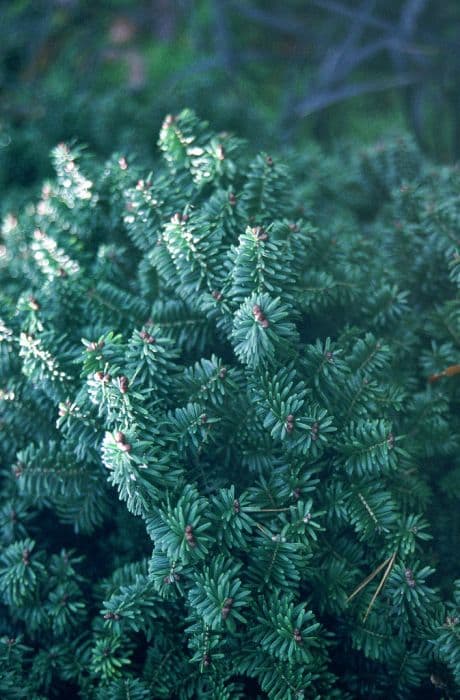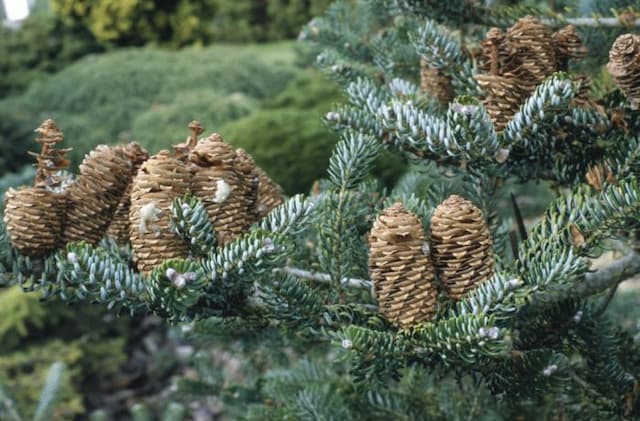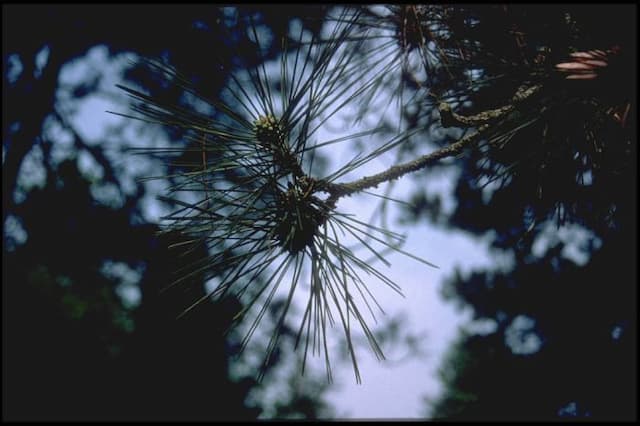Western Hemlock Tsuga heterophylla

ABOUT
The Western Hemlock is a visually striking evergreen conifer with a graceful, pyramidal shape. Its branches are arranged in a horizontally spreading fashion, often drooping at the ends, giving the tree a delicate and feathery appearance. The foliage of the Western Hemlock consists of needle-like leaves that are glossy and dark green on the top with two distinct white bands on the underside, which are rows of stomata. These needles are arranged spirally around the twigs but appear more flattened due to the twisted nature of their bases, allowing the needles to spread outwards on two sides of the branch. The bark of the Western Hemlock is deeply furrowed, with a rugged texture. It is initially reddish-brown in color and becomes darker and more furrowed with age. Smaller plants may have a smoother bark, but as they mature, the characteristic texture becomes more pronounced. During the spring season, small and inconspicuous flowers develop, which are followed by the production of cones. The cones are small, measuring just under an inch long, and hang pendulously from the branches. They are initially green and mature to a brown color over time. The cones hold the seeds of the Western Hemlock, which are also quite small and provide a means of reproduction for the tree.
About this plant
 Names
NamesFamily
Pinaceae.
Synonyms
Western Hemlock, Pacific Hemlock, West Coast Hemlock, Hinterland Hemlock.
Common names
Tsuga albertiana Sarg., Tsuga albertiana subsp. heterophylla (Raf.) A.E.Murray, Tsuga heterophylla var. albertiana (Sarg.) C.L.Hitchc., Tsuga heterophylla var. viridis Hornibr.
 Characteristics
CharacteristicsLife cycle
Perennials
Foliage type
Evergreen
Color of leaves
Green
Height
50-70 feet (15-21 meters)
Spread
20-25 feet (6-7.5 meters)
Plant type
Tree
Hardiness zones
5-7
Native area
North America
Benefits
 General Benefits
General Benefits- Ecosystem support: Western Hemlock provides habitat and food for wildlife, including birds, mammals, and insects.
- Aesthetic value: With its graceful form and evergreen foliage, Western Hemlock is used in landscaping for visual appeal.
- Timber production: It is an important source of wood for construction and paper products due to its strong and versatile timber.
- Soil stabilization: The root systems help stabilize soil and prevent erosion in forested areas.
- Carbon sequestration: As a coniferous tree, Western Hemlock captures carbon dioxide from the atmosphere, helping mitigate climate change.
- Shade and cooling: Its dense foliage provides shade which can cool environments and reduce the need for artificial cooling in nearby living spaces.
- Recreational use: Forests with Western Hemlock are often used for outdoor recreational activities such as hiking and nature observation.
- Cultural significance: Some Indigenous peoples use Western Hemlock for various cultural practices, including using the bark and roots for crafting.
 Medical Properties
Medical PropertiesThis plant is not used for medical purposes.
 Air-purifying Qualities
Air-purifying QualitiesThis plant is not specifically known for air purifying qualities.
 Other Uses
Other Uses- Woodworking: The wood of the western hemlock is workable and often used in light construction or for making crates and boxes.
- Tanning Leather: The bark contains tannins which can be used in the leather tanning process.
- Musical Instruments: The tonal quality of the wood makes it a potential material for soundboards in stringed musical instruments.
- Landscape Gardening: The western hemlock is often used as an ornamental tree for urban and landscape gardening due to its aesthetic appeal.
- Natural Dyes: Native American tribes have used the bark to make a natural dye for coloring wool and other materials.
- Navigation Aid: Some indigenous cultures have reportedly used the tree as markers or natural compasses, as they tend to grow with a lean pointing southwards in coastal regions.
- Animal Bedding: Wood shavings from the western hemlock are used as bedding for small animals like hamsters, gerbils, and rabbits.
- Pulp Production: The fibrous content of the wood makes it suitable for pulp production, which can be used in the paper-making industry.
- Fermentation Vats: Historically, some wooden barrels or fermentation vats were made from western hemlock due to its resistance to decay when kept wet.
- Traditional Carving: Indigenous peoples of the Pacific Northwest have used the wood of the western hemlock for carving totems and masks.
Interesting Facts
 Feng Shui
Feng ShuiThe Western Hemlock is not used in Feng Shui practice.
 Zodiac Sign Compitability
Zodiac Sign CompitabilityThe Western Hemlock is not used in astrology practice.
 Plant Symbolism
Plant Symbolism- Resilience: Tsuga heterophylla, commonly known as the Western Hemlock, is known for its ability to thrive in challenging environments, symbolizing the strength and resilience to withstand hardships.
- Longevity: As a species that can live for hundreds of years, the Western Hemlock represents endurance and longevity, suggesting a life of sustained health and vitality.
- Protection: With its dense canopy and evergreen nature, the Western Hemlock is often seen as a symbol of protection and shelter, offering a haven and support system.
- Healing: Indigenous cultures have used the bark of Western Hemlock for medicinal purposes, making it a symbol of healing and therapeutic properties.
- Peace: The Western Hemlock's tranquil presence in forests imparts a sense of peace and calm, symbolizing harmony with nature and a tranquil state of mind.
 Water
WaterWestern Hemlocks should be watered deeply and infrequently to mimic their natural habitat conditions. It's recommended to provide them with about 1.5 gallons of water per week, although this may vary depending on climate and soil conditions. In the summer or drier climates, you may need to water twice a week, while in cooler, wetter climates, less frequent watering is necessary. Ensure the soil remains consistently moist but not waterlogged, and reduce watering during the cooler months when the tree is not actively growing.
 Light
LightWestern Hemlocks thrive in partial to full shade, making them ideal for understory plantings in larger landscapes. They perform best in locations where they can receive dappled sunlight or shaded conditions, avoiding prolonged exposure to direct, intense sun. However, they can tolerate some morning sunlight with afternoon shade, or high canopy filtered light throughout the day.
 Temperature
TemperatureWestern Hemlocks are cold-hardy and can withstand a range of temperatures, typically surviving in conditions as low as -20 degrees Fahrenheit. They prefer cooler climates and are most comfortable in temperatures that do not exceed 80 degrees Fahrenheit. The ideal temperature range for growing a Western Hemlock is between 50 and 70 degrees Fahrenheit.
 Pruning
PruningWestern Hemlocks typically require minimal pruning, primarily to remove dead or diseased branches, or to shape the tree for aesthetic purposes. The best time to prune is late winter or early spring before the onset of new growth. They can be pruned annually if needed, but it's usually sufficient to inspect and prune every few years.
 Cleaning
CleaningNot needed
 Soil
SoilWestern Hemlock thrives best in well-draining, acidic soil with a pH range of 4.0 to 6.0. A mix of two parts peat, one part loam, and one part sand or perlite is ideal for potting to ensure good aeration and moisture retention.
 Repotting
RepottingWestern Hemlock, being a slow-growing tree, does not require frequent repotting. Young trees should be repotted every 2-3 years, while mature trees can go longer, potentially 3-5 years before needing a larger container.
 Humidity & Misting
Humidity & MistingWestern Hemlock prefers high humidity levels, typically between 70% to 90%. While it can tolerate lower humidity, maintaining higher humidity promotes healthier growth.
 Suitable locations
Suitable locationsIndoor
Provide bright, indirect light and maintain high humidity.
Outdoor
Plant in shade or partial sun, shelter from harsh winds.
Hardiness zone
5-9 USDA
 Life cycle
Life cycleThe Western Hemlock (Tsuga heterophylla) begins its life as a seed, typically dispersed by wind or wildlife. After germination in a suitable environment, which often includes moist, cool forest understory, the seedling emerges and establishes roots. The juvenile stage follows, marked by rapid vertical growth and the formation of a conical shape with whorled branches. As it matures into an adult tree, the Western Hemlock experiences a period of extensive growth, reaching up to 70 meters in height and developing a thick, furrowed bark. The reproductive phase occurs when the tree becomes capable of producing cones; male cones release pollen, while the larger female cones receive pollen and once fertilized, bear seeds. The life cycle culminates with the tree's eventual senescence and death, at which point it provides habitat and nutrients for forest ecosystems before the cycle begins anew with its seeds.
 Propogation
PropogationPropogation time
Late winter to early spring
Propogation: Western Hemlock (Tsuga heterophylla) is typically propagated by seed. The best time for sowing seeds is in the spring after the last frost. To propagate Western Hemlock by seed, the seeds should first be stratified (a process of simulating natural conditions that the seeds must experience before germination can occur). Stratification usually involves mixing the seeds with a moist medium such as sand or peat moss, then chilling them in a refrigerator at around 34 to 40 degrees Fahrenheit (1 to 4 degrees Celsius) for about one to three months. After stratification, the seeds are sown in well-drained soil and placed in a location with bright, indirect light, keeping the soil moist until germination occurs. Seedlings can be transplanted outdoors once they are strong enough, typically after their first or second year.









